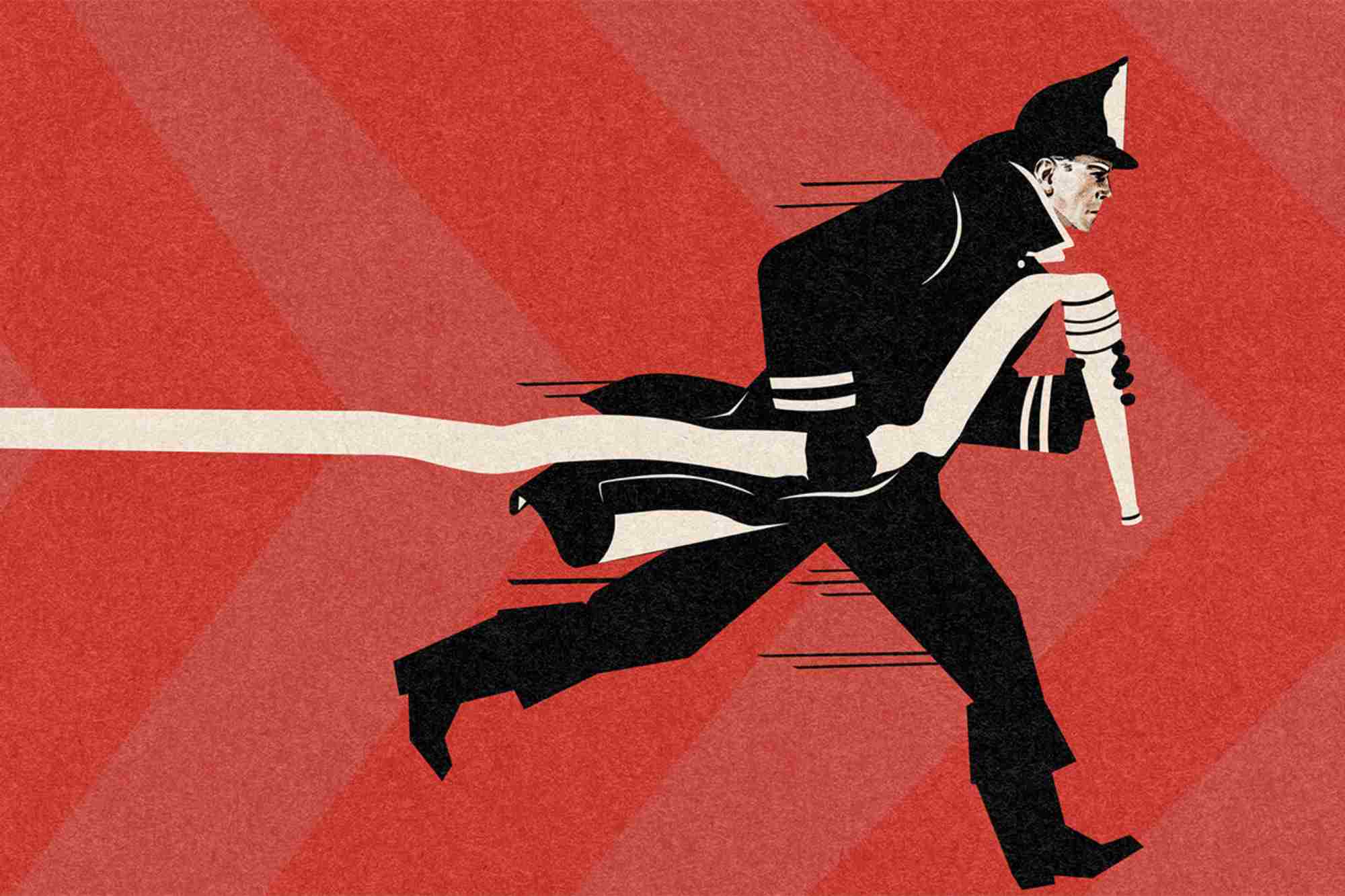Handle the Corporate Heat Like an Actual Firefighter
Many leaders think they’re great at battling corporate fires. The truth? There’s much to learn about planning, roles, tools, and communication from real firefighters.
News
- Nexus Closes Eighth Fund at $700 Million for Early-Stage Bets in India and US
- Amazon to Pump $12.7 Billion into India’s AI and Cloud Expansion
- Anthropic Debuts Interviewer Tool to Understand How People Really Use AI
- IPL Tops Google’s Search List for 2025 as AI Breaks Into India’s Top 10
- TeamLease Names Suparna Mitra MD & CEO in Leadership Overhaul
- Apple Loses Top UI Designer as Alan Dye Joins Meta

Picture this: You’re rappelling down the side of a burning building. Flames are everywhere. People are shouting for help.
You look up to see who’s holding the rope — who’s keeping you from falling hundreds of feet to the concrete sidewalk below — and it’s … you, yourself!
Feeling a bit panicky? The good news is, outside of work anxiety dreams, this would never happen. Real firefighters don’t wear dual hats when saving lives. You’d never be asked to both climb down the side of the building and hold the rope. It’s not physically possible.
But all too often in the corporate world, leaders pontificate about “fighting fires” while making boneheaded mistakes that real firefighters would never, ever make. They also typically use firefighting as a metaphor incorrectly: Real firefighting is actually quite organized.
As part of the research process for an upcoming book, I interviewed a New York City firefighter, Roland “Ro” Rodriguez, about how he does his (super important) job well. I had a hunch that when the chips are down — when lives are at stake — fighting real fires is a heck of a lot more orderly, codified, and systematized than fighting fires from behind a desk. My conversation with Rodriguez confirmed that belief in ways I could not have anticipated.
Here are four principles of real firefighting that we’d all do well to apply when fighting fires in the corporate world.
1. Do More Scenario Planning
Part of what’s intimidating about fighting real-world fires — and handling the array of other emergencies that firefighters deal with — is the sheer number of ways that things can go wrong. To begin with, nothing begins at the same starting point. As Rodriguez explained to me, no two fires are the same. No two car accidents are the same. Simple things like how locks are constructed change, so you could have to break through the same door twice in six months and find each experience completely different. Your starting place is always different, and a chaotic world takes you in a million possible directions from there. The wind could shift. An injured passenger could have a heart attack. The building could start collapsing.
Firefighters manage this world of seemingly infinite negative possibilities using scenario planning — right from the jump. The second a call comes in, they’re talking through all of the different variables to understand how the situation might progress, such as “What type of building is it? What floor is the fire on?”
We see ourselves as not having time to speculate — but we’re actually depriving ourselves of time to plan.
Once the firefighters are clear on the basics, they move into a quick round of scenario planning. Where might the fire travel? What might be the obstacles to extricating passengers from a wreck? Rodriguez characterizes this discussion as an interesting combination of applying battle-tested expertise and acknowledging the need to test and learn: “Oh, I’ve seen this before, but this is a little different. Let me try it this way.”
Leaders often neglect these two steps — crisply defining the problem, and (especially) thinking through different ways it might progress — in moments of corporate firefighting. In complex organizations, the problem is often defined by everyone’s experience of it — which is like saying, “My problem is smoke. Yours is flames.”
Folks: It’s the same fire. However, we’ve been shielded from looking at it that way by factors ranging from overly granular incentives (which cause us to manage what’s directly in front of us instead of solving complex problems at the root) to straight-up courage failures (where we’re frightened to speak up about harder-to-address problems).
All of this obfuscation of the problem is a real shame because it keeps us from getting to the step that’s interesting, useful, and even sometimes intellectually enjoyable: scenario-planning how things might go, in service of warding off the worst potential outcomes.
Scenario planning represents real firefighters’ No. 1 defense against spiraling chaos: thinking about how things might get worse, and seeking to stop them from following those paths. If you think the fire is likely to spread to the fifth floor, you do things to manage it on the fourth floor. That single question — “What might happen?” — is a powerful one. But we don’t ask it often enough in the corporate world. Fear and the perception of time constraints both play a role here. We see ourselves as not having time to speculate — but we’re actually depriving ourselves of time to plan. And if firefighters can take a second to do it in the midst of, literally, a raging fire, I would argue that we can all pause and play out the next few steps.
2. Get Real About Role Clarity
We get silly with roles in the corporate world: dotted reporting lines; co-heads; goofy titles; zillions of conflicting committees; and, of course, the aforementioned “dual hatting.” I once saw an org chart for part of a world-famous company, created by a world-famous set of consultants, that was not intuitively recognizable as a corporate structure. The org chart resembled a game of Space Invaders: Stuff just floated everywhere. The mind boggles.
Real firefighters don’t get creative on job titles. Nobody’s out there serving as “head of gas fume awareness” — but everyone has a specific role whose value is readily apparent. Moreover, it’s clear to everyone on the team how all of the roles work together. Every time Rodriguez described a challenging situation to me, he made clear that everyone had a different job … and that those jobs can’t overlap or conflict. It’s no good if everyone jumps into the water for a water rescue; someone has to stand at the shoreline and hold the rope attached to the individual who did jump in to do the rescue.
Every foundational scenario — whether a high-rise inferno, a person floating in the river, or a car T-boned at an intersection — has a basic team structure associated with it for the firefighters who respond. Situations morph in real time, of course, but there’s a common understanding of what the roles look like.
All too often, role clarity is the first thing to go out the window when we’re fighting fires in the corporate world. This sometimes comes from a well-intentioned place: It’s all-hands-on-deck and we all just want to help, however we can.
There’s also a classic “teams of teams” glitch here. We may know our roles within our core teams quite clearly, but when we face a gnarly problem that has to be addressed across teams, siloes, departments, or functions, or even across organizations within an ecosystem, we rarely stop to figure out exactly what everyone’s job is within the new team.
So take a cue from the firefighting book, and clarify roles — especially in the worst “firefights.” Be super vigilant about overlap, gray areas, and conflicts in roles — the places where, were things really on fire, problems would reveal themselves very quickly.
3. Genuinely Know Your Tools and Their Potential
Perhaps the part of my conversation with Rodriguez that surprised me the most was our discussion of technology. In a mainstream corporate context, we’re not always dedicated and enthusiastic users of the tech we’re given — especially at a time when, on average, we use 11 or so apps a day, according to Gartner research. You might have a system or two where you’re a real whiz, but as a standard-issue knowledge worker, you’re generally basically just getting by, with a bunch of tabs open and some grumbling when you get an error message or a crash.
Not so for firefighters. They’re passionate and engaged users of the technology they deploy. Rodriguez, at the time we spoke, was about to head to Roosevelt Island for a course on a new kind of rope. Firefighters, he explained, focus heavily on being able to use tools well. Each axe, for instance, has multiple ways it can be used, and firefighters challenge themselves to know all of them and excel in practice.
All too often, role clarity goes out the window when we’re fighting fires in the corporate world.
I got to see this play out live recently, when a sudden power cut trapped my husband in our building’s elevator. The New York City Fire Department showed up immediately, toting a wide array of tools. When it became apparent that my husband had made it only a few feet down before the elevator got stuck, I pictured them wedging the elevator door open with some sort of jaws-of-life contraption — or maybe an axe! Or multiple axes. This was going to be some wild mechanical operation.
Except it wasn’t. Elevators, it turns out, have this little hole in their doors. And there’s a special key that firefighters in metropolitan areas carry that they put into that special keyhole so that the doors pop right open. In less than five minutes, the firefighters had opened the doors and pulled my husband out. The right tech for the right occasion brought a tough situation to an easy conclusion.
When I think about the surprising ease of that moment, I’m challenged to come up with a moment when technology has so neatly solved a problem for me in recent years. But I’m also conscious that I do not know the technology I work with as well as these firefighters know theirs — and again, I’m not alone in that. Many of us, probably even most of us, are not superusers of the technologies we use every day at work.
In critical, high-stress moments, if there were a technological solution to at least some of our woes, we might have no idea what it might be. It’s worth exploring whether more personal, hands-on technological understanding might make us exponentially more effective.
4. Overcommunicate — and Spur Positive Emotion
If I said that key skills for a certain role were coordination, active listening, communication, and social perceptiveness, you might not immediately guess that the role in question is, in fact, being a firefighter. But those are four of the 15 skills the U.S. government officially attaches to the job of firefighting in O*Net, its comprehensive database on the composition of jobs. (The slightly less comprehensive, but more vivid, database of jobs is of course Richard Scarry’s 1968 classic, What Do People Do All Day?, where characters like Huckle the cat, Captain Salty, and Mayor Fox illustrate a generous array of occupations.)
Communication is core to the job of firefighting, and, as Rodriguez explained to me, real performance in the role is driven by overcommunication. He explained that he communicates constantly with teammates on two different levels: constantly coordinating around the situation and the actions they’re taking in real time, and reinforcing coworkers’ energy under tough conditions. (“Hey, you’re doing the best job you could possibly do. Keep going.”) Everything is verbalized and checked on in real time, and keeping the team’s spirits up is a core goal — not an ancillary “nice to have.”
It seems apparent that this way of communicating keeps complex, fluid situations from going off the rails, but think about how differently this plays out in the corporate world. In corporate firefighting situations, we often consider it a waste of time to narrate our actions — or to coordinate in real time with others. As a result, simple questions like “Who needs to see that deliverable before it goes out the door?” or “Who can make that decision?” all too often slip through the cracks, causing chaos to grow.
Worse, overloaded leaders and teammates alike often inject negative energy into critical moments to try to create urgency, leaving already exhausted folks in even worse shape. Imagine if your communications stream looked more like the real firefighters’ example: an unemotional, live discussion of who is doing what, when, and why, with repeated check-ins and clarifications. In this way of operating, folks would take the extra moment to clarify even what may seem like fairly basic actions — “working out loud,” if you’re familiar with the term — and to encourage one another. Great leaders do this intuitively, recognizing that unless someone is about to make a terrible mistake, negatively tinged feedback in tricky situations just drains the group’s energy.
Most of us could never do the job of actual firefighting. It’s physically and emotionally intense and requires bravery and equanimity in high doses. But we can definitely benefit from the wisdom of firefighting as we “fight fires.” Firefighters do high-stakes work with an elegant clarity that can help us in the corporate world, too. The working world is chaotic, but we can make the choice to face the flames in a more thoughtful manner.
Thank you to Roland “Ro” Rodriguez for the insight that fueled this article, and thank you also to the New York City Fire Department personnel who got my husband out of the elevator.




